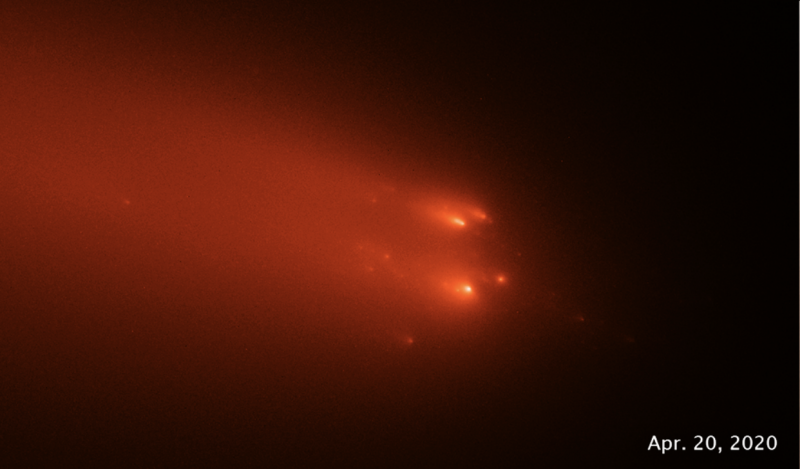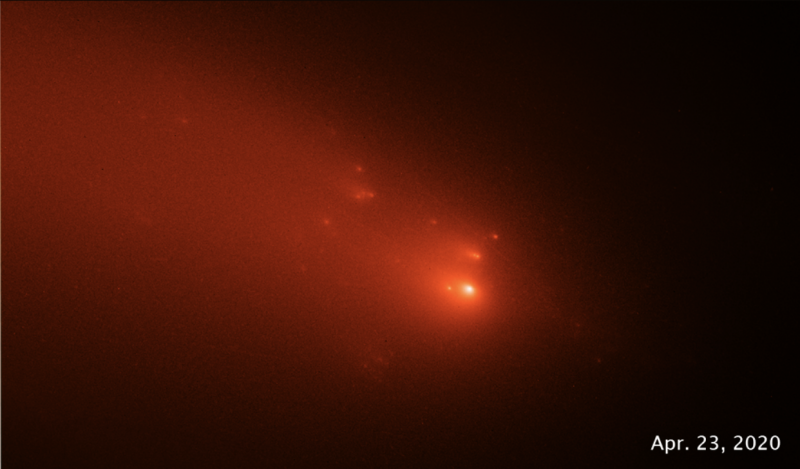
Astronomers using the Hubble Space Telescope said late last week that an early brilliant comet, witnessed by our ancestors 5,000 years ago, might be related to Comet ATLAS, which broke apart in our sky in 2020. That early comet would have been seen in the predawn sky. HubbleSite explained:
There is no direct evidence for this visitor because the start of recorded history was still a few centuries away … [but it] might have been a spectacular sight to civilizations across Eurasia and North Africa at the end of the Stone Age.
Astronomers now believe this early comet might have split into at least two pieces. After rounding the sun, both pieces headed out again to the outer solar system, not to return for 5,000 years. Astronomers now believe the great comet of 1844 – which was nearly as bright as the brightest star Sirius – was one fragment of this early visitor. That fragment won’t return again until the 50th century. But the second fragment, now called Comet ATLAS (C/2019 Y4), appeared near the beginning of 2020. And, as astronomers watched, that fragment – our Comet ATLAS – disintegrated into a cascade of small icy pieces. HubbleSite explained:
In a new study using the Hubble Space Telescope, astronomer Quanzhi Ye of the University of Maryland in College Park reported that ATLAS is a broken-off piece of that ancient visitor from 5,000 years ago. Why? Because ATLAS follows the same orbital ‘railroad track’ as that of a comet seen in 1844. This means the two comets are probably siblings from a parent comet that broke apart many centuries earlier. Amateur astronomer Maik Meyer first noted the link between the two comets.
Such comet families are common. The most dramatic visual example was in 1994 when the doomed comet Shoemaker-Levy 9 was pulled into a string of pieces by Jupiter’s gravitational pull. This ‘comet train’ was short-lived. It fell piece by piece into Jupiter in July 1994.
Astronomer Ye observed Comet ATLAS with the Hubble Space Telescope around the time of its 2020 breakup. He said the comet is just “weird.” That’s because it disintegrated while farther from the sun than Earth, at a distance of over 100 million miles (160 million km). Most comets break up closer to the sun, if they’re going to break up. Ye said:
This emphasizes its strangeness.
If it broke up this far from the sun, how did it survive the last passage around the sun 5,000 years ago? This is the big question. It’s very unusual because we wouldn’t expect it. This is the first time a long-period comet family member was seen breaking up before passing closer to the sun.
Ye and his colleagues reported in their new study that one fragment of ATLAS disintegrated in a matter of days, while another piece lasted for weeks. Ye commented:
This tells us that part of the nucleus was stronger than the other part.
They said that Comet ATLAS might have had streamers of ejected material extending from it. Those streamers might have spun up the comet (increased its rotation rate) to such a speed that centrifugal forces tore it apart. An alternative explanation, HubbleSite explained, is that the comet has so-called super-volatile ices that just blew the fragment apart like an exploding aerial firework.

Bottom line: Comet C/2019 Y4 (ATLAS) was seen to break apart in 2020, while still relatively far from the sun. An astronomer has traced its path backward in time, to deduce it was seen by our early ancestors.











